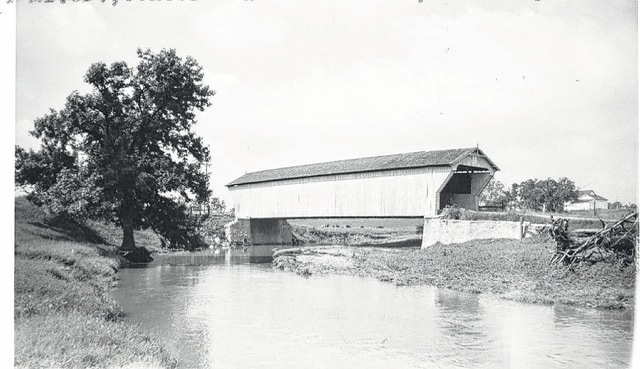
EATON — The Harshman is the next oldest covered bridge, built in 1894 and placed on the National Registry of Historic Places in 1976, is 109 feet long and was constructed at a cost of $ 3,184.
Evret S. Sherman built the Childs Truss superstructure and J.M. Acton was responsible for the masonry walls. The bridge is located over Four Mile Creek on Concord-Fairhaven Rd., about one-half mile south of the Concord Church and just west of the former site of the Dixon-Israel School in Dixon Township. (That reminds me of a near-tragic story that happened at the time of the demolition of the School I will relate later in the article.) Stone for the abutments was hauled from Stony Point quarry located a short distance south of the bridge. Unsubstantiated stories include a sawmill that once stood along the creek near the bridge site that provided lumber for the project.
On a side note, most of the stone quarried for bridge abutments was located relatively near bridge locations. There were many small quarries located within Preble County and this area is known for its fine quality of limestone. For example, the stone from the big Lewisburg quarry, located just north of Route 40, was used up until the 1970s for steel production in the eastern Ohio and western Pennsylvania steel mills.
The bridge was constructed on a 63.85 acre tract owned by J.P. Harshman. All the covered bridges in Preble County, with the exception of Dixon’s Branch, received their name from the landowner of the property at the time of construction of the bridge. The Preble County Engineer has an 1897 wall map of Preble County that is very interesting to look at. Of course, you have to be a geek like me who likes Preble County history and maps to find it fascinating.
In 2003, the Preble County Engineer’s Office was contacted by the Christopher H. Marston of the Historic American Engineering Record (HAER) to document the uniqueness of a Childs truss. HAER was established in 1969 by the National Park Service, the American Society of Civil Engineers and the Library of Congress to document historic sites, such as covered bridges. The report indicated “The main objective of this report was to quantify the behavior of the Harshman Bridge through physical experiments and dead load, live load, and creep analyses. Another objective was to compare the Childs truss form to its contemporary truss types, Long, Howe, and Pratt.”
“Overall, there was good correspondence between the analytical predictions of the models and the experimental measurements taken on the Harshman Bridge. The excellent condition of this bridge, which is over a century old, merits attention and praise, and it serves as an outstanding example of why efforts should be made to conserve the engineering landmarks of our past.”
We should be quite proud of the fact that the experts in covered bridge circles realize Preble County is one of the nation’s leaders in covered bridge preservation and restoration.
Speaking of restoration, a rehabilitation project began in December 2007 and was completed in May, 2008 at an approximate cost of $340,000. Deficient members were either replaced or strengthened to raise the load limit of this bridge from 6 tons to 15 tons. The project utilized 95 percent federal funding.
I almost forgot about the near fatal event for the Harshman. Anyways, as stated earlier, a contract was issued to demolish Dixon-Israel School. The contractor had a bulldozer on site to aid in the demolition. One day while the equipment was on site, someone started the engine on the bulldozer, put it in gear and jumped off while the bulldozer headed westerly. The bulldozer ran over everything in its path and was headed for the Harshman. Somehow, a large round bale of hay was in the bulldozer’s path and as the bulldozer was approaching the Harshman the round bale was pushed into the side ditch of Concord-Fairhaven Rd. within approximately 30 feet of the bridge. The bulldozer went over the round bale and was lifted off its tracks and there the bulldozer sit with the engine running and the tracks spinning. Someone called the Sheriff’s Office who called Kevin Nelson, the Highway Superintendent for the Preble County Engineer’s Office to see if he could remedy the situation of the runaway bulldozer. To make a long story short, Kevin made his way onto the machine with the spinning tracks and safely shut down the bulldozer. So, the Harshman was saved from a near fatal blow by a runaway bulldozer. As they say, you just can’t make this stuff up.
Indians remained longer in the Four Mile creek area than in any other part of Preble County. A few families of Delaware Indians camped here as late as 1815, giving this part of Four Mile Valley the setting for the Legend of Tallawanda. As you recall, in the last article I referred to the legend. The following is taken from Covered Bridges of Preble County, Ohio by Seth S. Schlotterbeck.
“As the story is told, Tallawanda, a beautiful Indian maiden, had her jealously and wrath aroused when her dusky suitor suggested to her that if she would go down near a certain large sycamore tree growing in the creek bank, she could see “the most beautiful girl in the forest.”
Curiosity overcame her anger. She went to the place described but could see no one. Then she happened to look down into the little pool of still water below the tree where she saw her reflection in its clear depths. Tallawanda! The most beautiful girl in the forest! A big wedding pow-wow soon followed.”
Ahhhhh, as my wife would say.


